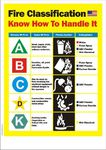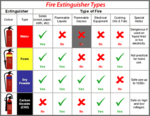Fire Extinguisher & Equipment F.A.Q.
Frequently Asked
Questions
Below is a collection of frequently asked questions about fire extinguishers and servicing
How do I know if my extinguisher needs service?
All Fire Extinguishers are required to have yearly maintaince by a service professional to make sure it's still safe and keep it up to date. Most extinguishers need service every 6 years to be taken apart, checked inside and out, and then recharged. If your extinguisher gauge is not in the green, no matter when the last service was done, it needs to be taken in for service to have that problem fixed.
My extinguisher pressure gauge is showing too high a pressure. Is this a problem?
If the needle is still within the green section of the gauge it is ok. If however it has crept in to the red then the extinguisher needs attention immediately.
My pull pin is bent? Do I have to replace the pin and how?
Yes the pin would need replacing as is could jam in an emergency. It can be replaced by breaking the tamper seal, removing the old pin, inserting a new pin and replacing the tamper seal. This should be performed by a service professional.
Properly using a fire extinguisher in the workplace
According to OSHA, the most common emergency small businesses must plan for is a fire. Fire extinguishers can be invaluable tools to help fight smaller fires in the workplace or to protect evacuation routes in the event of a larger one.
OSHA requires employers to thoroughly train workers not only how to use an extinguisher properly, but also how to accurately assess a situation and determine when evacuation is the safest course of action. OSHA requires employees to be trained in fire extinguisher use on an annual basis, at a minimum.
A simple fire extinguisher training technique to use with employees is the PASS method:
- Pull the pin on the extinguisher.
- Aim the hose nozzle low toward the base of the fire.
- Squeeze the handle to release the extinguishing agent.
- Sweep the nozzle from side to side at the base of the flames until extinguished.
Knowing how to operate the extinguisher is not the end of training. Employee responders to a fire also should be trained to adhere to the following protocol:
- If appropriate, sound the fire alarm or call the fire department immediately.
- Before approaching the fire, determine an evacuation route safe of flames, excessive heat and smoke. Do not allow this evacuation route to become blocked.
- Use the PASS technique for discharging an extinguisher and back away from the area if the fire flares up again.
- If the extinguisher is empty and the fire is not out, evacuate immediately.
- If the fire grows beyond what can be safely handled, evacuate immediately.
Fire extinguishers are meant to handle only small fires. If a fire becomes too large or the environment becomes too dangerous, employees should know when and how to evacuate the area. If any of the following conditions are present, workers should follow evacuation procedures immediately and should not attempt to fight the fire with an extinguisher:
The fire is too large. The fire involves flammable solvents, is partially hidden behind a wall or ceiling, cannot be reached from a standing position, or covers more than 60 square feet in area.
The air is unsafe to breathe. Levels of smoke make the fire impossible to fight without some form of respiratory protection.
The environment is too hot or smoky. Radiated heat is easily felt, making it hard to approach a fire within adequate range of using the extinguisher (about 10-15 feet). It is necessary to crawl on the floor to avoid heat or smoke. Visibility is poor.
Evacuation paths are impaired. The fire is not contained and heat, smoke or flames block potential evacuation routes.




